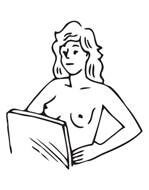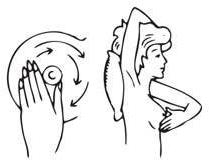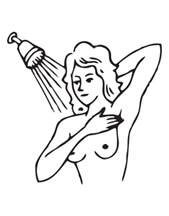

While a breast self-exam is a useful tool for the early detection of breast cancer, it should not take the place of a regular mammogram and clinical breast exams. Self-exams will help you become familiar with how your breast normally looks and feels.
Adult women of all ages are encouraged to perform breast self-exams at least once a month. This simple procedure should be done 7-10 days after your menstrual period starts. After menopause or following a hysterectomy, breasts should be examined on the same day of each month, such as the 1st or the 15th day of the month.

1. In the Mirror
With your hands at your side, look for changes in the shape, size or skin texture of your breasts. Raise your arms over your head, and repeat your visual examination. Gently squeeze each nipple between your thumb and forefinger to check for discharge.

2. Lying Down
To examine your right breast, put a pillow under your right shoulder; put your right arm behind your head. Use the finger pads (not your fingertips) of the middle fingers of your left hand to press firmly on your right breast. Check for lumps or thickening. Examine your breasts in the same manner each time, in one of the following ways:
Repeat on your left side.

3. In the Shower
Fingers may slide more easily over wet, soapy skin, making lumps and other changes easier to feel. Remember to check the entire breast and underarm area. Stand in the shower, and use the same technique as in the lying-down exam. Use your right hand for the left breast and your left hand for the right breast.
Report any changes or irregularities to your healthcare provider.
Age 40+
Ages 18-39
These recommendations are not intended as a replacement for professional care. For complete diagnosis and treatment, see your healthcare professional.
Schedule your 3D mammogram today.
Call North Oaks Patient Scheduling between
7 am and 5 pm, Monday through Friday.
Hammond: (985) 230-7777
Livingston: (225) 686-4899
If you are a medical provider and need to send an order, please fax (985) 230-6781.